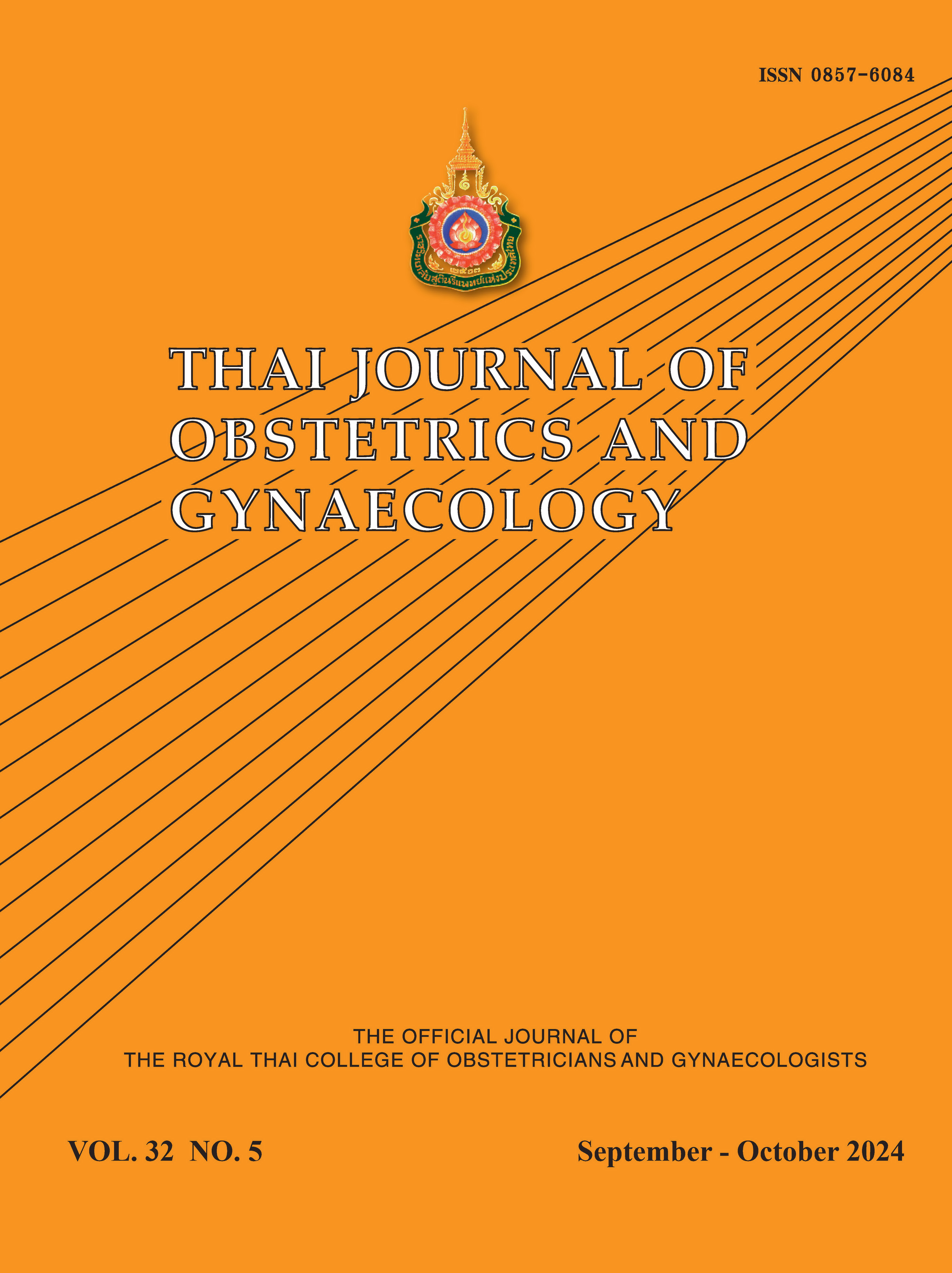Prevalence of Endometrial Cancer in Patients with Endometrioid Intraepithelial Neoplasia (EIN) Histology
Main Article Content
Abstract
Objective - This study aims to determine the prevalence of concurrent endometrial cancer in the patients who had Endometrioid Intraepithelial Neoplasia (EIN) histology obtained from endometrial biopsy tissues.
Materials and Methods - This retrospective study recruited all patients diagnosed with EIN obtained through endometrial biopsy that was collected from endometrial sampling, fractional curettage, or hysteroscopic biopsy from the year 2015 to 2019. The demographic information and the final pathology following their hysterectomy specimens were gathered to evaluate the concurrent endometrial cancer. In the non-surgical group, they would be categorized as having no concurrent cancer if the follow-up period was up to 12 months and there was no malignancy found. Multivariable logistic regression analysis was used to evaluate the association between demographics and clinical factors with concurrent endometrial cancer.
Results - 130 EIN patients were enrolled. The mean age was 47.02 (SD = 13.2) years for those diagnosed with concurrent endometrial cancer and 52.23 (SD = 10.9) years for those who were not diagnosed with endometrial cancer. Prevalence of concurrent endometrial cancer in EIN was 23.1%, (95% confidence interval, 16.1 to 31.2). All concurrent endometrial cancer patients were diagnosed with uterine confined disease. There were no diagnoses of stage III or IV of disease.
Conclusion - one-fourth of the patients diagnosed with EIN from endometrial sampling had concurrent endometrial cancer. All patients diagnosed with concurrent endometrial cancer had the uterine confined disease. We recommend to use these data for counselling the patients who have EIN in both surgical and conservative cases.
Article Details

This work is licensed under a Creative Commons Attribution-NonCommercial-NoDerivatives 4.0 International License.
References
Sung H, Ferlay J, Siegel RL, Laversanne M, Soerjomataram I, Jemal A, et al. Global cancer statistics 2020: GLOBOCAN estimates of incidence and mortality worldwide for 36 cancers in 185 countries. CA Cancer J Clin 2021;71:209-49.
Mutter GL, Zaino RJ, Baak JP, Bentley RC, Robboy SJ. Benign endometrial hyperplasia sequence and endometrial intraepithelial neoplasia. Int J Gynecol Pathol 2007;26:103-14.
Sobczuk K, Sobczuk A. New classification system of endometrial hyperplasia WHO 2014 and its clinical implications. Prz Menopauzalny 2017;16:107.
Dietel M. The histological diagnosis of endometrial hyperplasia. Virchows Archiv 2001;439:604-8.
Sanderson PA, Critchley HO, Williams AR, Arends MJ, Saunders PT. New concepts for an old problem: the diagnosis of endometrial hyperplasia. Hum Reprod Update 2017;23:232-54.
Baak J, Wisse-Brekelmans E, Fleege J, Van Der Putten H, Bezemer P. Assessment of the risk on endometrial cancer in hyperplasia, by means of morphological and morphometrical features. Pathol Res Pract 1992;188:856-9.
Trimble CL, Kauderer J, Zaino R, Silverberg S, Lim PC, Burke JJ, et al. Concurrent endometrial carcinoma in women with a biopsy diagnosis of atypical endometrial hyperplasia: a Gynecologic Oncology Group study. Cancer 2006;106:812-9.
Denlinger CS, Sanft T, Moslehi JJ, Overholser L, Armenian S, Baker KS, et al. NCCN guidelines insights: survivorship, version 2.2020. J Natl Compr Canc Netw 2020;18:1016-23.
Hamilton CA, Pothuri B, Arend RC, Backes FJ, Gehrig PA, Soliman PT, et al. Endometrial cancer: A society of gynecologic oncology evidence-based review and recommendations. Gynecol Oncol 2021;160:817-26.
Byun JM, Jeong DH, Kim YN, Cho EB, Cha JE, Sung MS, et al. Endometrial cancer arising from atypical complex hyperplasia: The significance in an endometrial biopsy and a diagnostic challenge. Obstet Gynecol Sci 2015;58:468-74.
Chen YL, Wang KL, Chen MY, Yu MH, Wu CH, Ke YM, et al. Risk factor analysis of coexisting endometrial carcinoma in patients with endometrial hyperplasia: a retrospective observational study of Taiwanese Gynecologic Oncology Group. J Gynecol Oncol 2013;24:14-20.
Chen YL, Cheng WF, Lin MC, Huang CY, Hsieh CY, Chen CA. Concurrent endometrial carcinoma in patients with a curettage diagnosis of endometrial hyperplasia. J Formos Med Assoc 2009;108:502-7.
Doherty MT, Sanni OB, Coleman HG, Cardwell CR, McCluggage WG, Quinn D, et al. Concurrent and future risk of endometrial cancer in women with endometrial hyperplasia: A systematic review and meta-analysis. PloS one 2020;15:e0232231.
Baak JP, Mutter GL, Robboy S, Van Diest PJ, Uyterlinde AM, Ørbo A, et al. The molecular genetics and morphometry‐based endometrial intraepithelial neoplasia classification system predicts disease progression in endometrial hyperplasia more accurately than the 1994 World Health Organization classification system. Cancer 2005;103:2304-12.
Hecht JL, Ince TA, Baak J, Baker HE, Ogden MW, Mutter GL. Prediction of endometrial carcinoma by subjective endometrial intraepithelial neoplasia diagnosis. Mod Pathol 2005;18:324-30.
Kender Erturk N, Basaran D, Salman C. Comparison of endometrial cancer risk in patients with endometrial precancerous lesions: WHO 1994 vs EIN classification. J Obstet Gyneol 2021;42:1-4.


